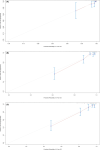A novel prognostic model predicts overall survival in patients with nasopharyngeal carcinoma based on clinical features and blood biomarkers
- PMID: 33973727
- PMCID: PMC8178501
- DOI: 10.1002/cam4.3839
A novel prognostic model predicts overall survival in patients with nasopharyngeal carcinoma based on clinical features and blood biomarkers
Abstract
This study aims to develop and validate a novel prognostic model to estimate overall survival (OS) in nasopharyngeal carcinoma (NPC) patients based on clinical features and blood biomarkers. We assessed the model's incremental value to the TNM staging system, clinical treatment, and Epstein-Barr virus (EBV) DNA copy number for individual OS estimation. We retrospectively analyzed 519 consecutive patients with NPC. A prognostic model was generated using the Lasso regression model in the training cohort. Then we compared the predictive accuracy of the novel prognostic model with TNM staging, clinical treatment, and EBV DNA copy number using concordance index (C-index), time-dependent ROC (tdROC), and decision curve analysis (DCA). Subsequently, we built a nomogram for OS incorporating the prognostic model, TNM staging, and clinical treatment. Finally, we stratified patients into high-risk and low-risk groups according to the model risk score, and we analyzed the survival time of these two groups using Kaplan-Meier survival plots. All results were validated in the independent validation cohort. Using the Lasso regression, we established a prognostic model consisting of 13 variables with respect to patient prognosis. The C-index, tdROC, and DCA showed that the prognostic model had good predictive accuracy and discriminatory power in the training cohort than did TNM staging, clinical treatment, and EBV DNA copy number. Nomogram consisting of the prognostic model, TNM staging, clinical treatment, and EBV DNA copy number showed some superior net benefit. Based on the model risk score, we split the patients into two subgroups: low-risk (risk score ≤ -1.423) and high-risk (risk score > -1.423). There were significant differences in OS between the two subgroups of patients. Similar results were observed in the validation cohort. The proposed novel prognostic model based on clinical features and serological markers may represent a promising tool for estimating OS in NPC patients.
Keywords: lasso regression; model; nasopharyngeal carcinoma; nomogram; prognostic.
© 2021 The Authors. Cancer Medicine published by John Wiley & Sons Ltd.
Conflict of interest statement
The authors declare that they have no conflict of interest.
Figures







Similar articles
-
Assessment of Survival Model Performance Following Inclusion of Epstein-Barr Virus DNA Status in Conventional TNM Staging Groups in Epstein-Barr Virus-Related Nasopharyngeal Carcinoma.JAMA Netw Open. 2021 Sep 1;4(9):e2124721. doi: 10.1001/jamanetworkopen.2021.24721. JAMA Netw Open. 2021. PMID: 34554238 Free PMC article.
-
Prognostic values of the integrated model incorporating the volume of metastatic regional cervical lymph node and pretreatment serum Epstein-Barr virus DNA copy number in predicting distant metastasis in patients with N1 nasopharyngeal carcinoma.Chin J Cancer. 2017 Dec 29;36(1):98. doi: 10.1186/s40880-017-0264-x. Chin J Cancer. 2017. PMID: 29284539 Free PMC article.
-
Prognostic nomogram for patients with Nasopharyngeal Carcinoma incorporating hematological biomarkers and clinical characteristics.Int J Biol Sci. 2018 Apr 5;14(5):549-556. doi: 10.7150/ijbs.24374. eCollection 2018. Int J Biol Sci. 2018. PMID: 29805306 Free PMC article.
-
Epstein-Barr Virus DNA in Nasopharyngeal Carcinoma: A Brief Review.Methods Mol Biol. 2020;2204:99-107. doi: 10.1007/978-1-0716-0904-0_9. Methods Mol Biol. 2020. PMID: 32710318 Review.
-
Prognostic value of Epstein-Barr virus DNA level for nasopharyngeal carcinoma: a meta-analysis of 8128 cases.Eur Arch Otorhinolaryngol. 2020 Jan;277(1):9-18. doi: 10.1007/s00405-019-05699-9. Epub 2019 Oct 28. Eur Arch Otorhinolaryngol. 2020. PMID: 31659449 Review.
Cited by
-
Cytoplasmic poly(A)-binding protein 1 (PABPC1) is a prognostic biomarker to predict survival in nasopharyngeal carcinoma regardless of chemoradiotherapy.BMC Cancer. 2023 Feb 20;23(1):169. doi: 10.1186/s12885-023-10629-4. BMC Cancer. 2023. PMID: 36803974 Free PMC article.
-
Epidemiology of nasopharyngeal carcinoma: current insights and future outlook.Cancer Metastasis Rev. 2024 Sep;43(3):919-939. doi: 10.1007/s10555-024-10176-9. Epub 2024 Mar 2. Cancer Metastasis Rev. 2024. PMID: 38430391 Review.
-
Nomogram Based on Liver Function Test Indicators for Survival Prediction in Nasopharyngeal Carcinoma Patients Receiving PD-1 Inhibitor Therapy.Curr Oncol. 2023 Jul 26;30(8):7189-7202. doi: 10.3390/curroncol30080521. Curr Oncol. 2023. PMID: 37623002 Free PMC article.
-
Advances in Nasopharyngeal Carcinoma Staging: from the 7th to the 9th Edition of the TNM System and Future Outlook.Curr Oncol Rep. 2025 Mar;27(3):322-332. doi: 10.1007/s11912-025-01651-9. Epub 2025 Feb 25. Curr Oncol Rep. 2025. PMID: 39998781 Review.
-
Early detection of nasopharyngeal carcinoma through machine-learning-driven prediction model in a population-based healthcare record database.Cancer Med. 2024 Apr;13(7):e7144. doi: 10.1002/cam4.7144. Cancer Med. 2024. PMID: 38545735 Free PMC article.
References
-
- Torre LA, Bray F, Siegel RL, Ferlay J, Lortet‐Tieulent J, Jemal A. Global cancer statistics, 2012. CA Cancer J Clin. 2015;65(2):87‐108. - PubMed
-
- Leong YH, Soon YY, Lee KM, Wong LC, Tham IWK, Ho FCH. Long‐term outcomes after reirradiation in nasopharyngeal carcinoma with intensity‐modulated radiotherapy: a meta‐analysis. Head Neck. 2018;40(3):622‐631. - PubMed
-
- Zhang LI, Huang Y, Hong S, et al. Gemcitabine plus cisplatin versus fluorouracil plus cisplatin in recurrent or metastatic nasopharyngeal carcinoma: a multicentre, randomised, open‐label, phase 3 trial. Lancet. 2016;388(10054):1883‐1892. - PubMed
-
- Ng WT, Yuen KT, Au KH, Chan OS, Lee AW. Staging of nasopharyngeal carcinoma–the past, the present and the future. Oral Oncol. 2014;50(6):549‐554. - PubMed
Publication types
MeSH terms
Substances
LinkOut - more resources
Full Text Sources
Other Literature Sources

